A Summer Walk in Shropshire
Contours enjoy rolling farmland and shady footpaths on a summer walk in Shropshire, from Bishop's Castle to Clun.
A Summer Walk in Shropshire
https://www.contours.co.uk/a-summer-walk-in-shropshire
by Cass Jenks
It’s always exciting when a lesser-known but absolutely brilliant trail starts to get the attention we all know it deserves. This year, that’s finally happening for our Shropshire Hills circular walking holiday, a tour through rolling landscapes that threatens to usurp the Cotswolds as king of rural British charm.
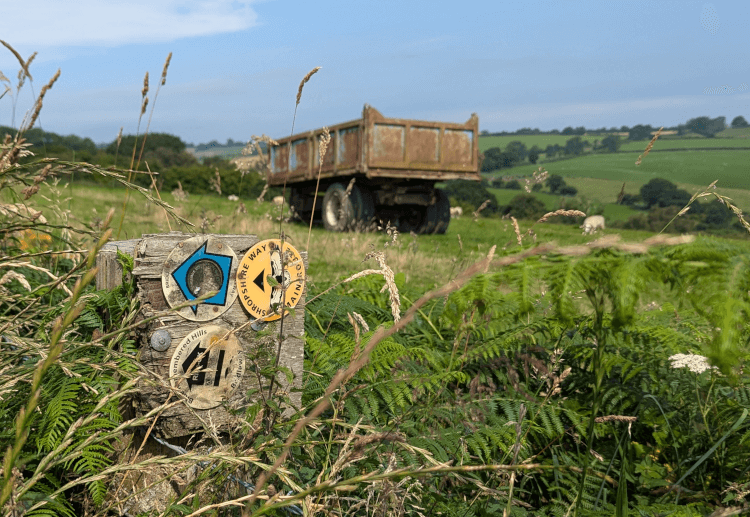
Our Shropshire Hills holiday features towns and villages full of independent shops, cafes, famous pubs and even castle ruins, and it rambles between them through mixed woodland, open grassland and hedge-hemmed fields, with impressive sights like Long Mynd and Stiperstones to enjoy.
To perfect this lovely ramble, Contours Holidays decided to get out this month and give our home-written route notes some extra polish. Our managing director, Karen, planned to walk most of the Shropshire Hills herself (you can hear a little from Karen in this interview about the Shropshire Hills, or read her blog about the complete walk) but as one stage would be a touch too long for her pups’ little legs, I stepped in to check it out.
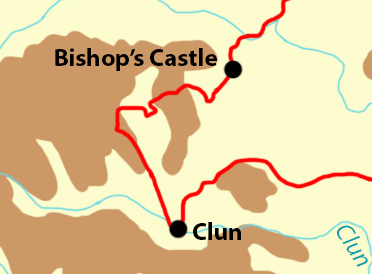
My hike along the Shropshire Hills walking holiday would span 12 miles (19km) from Bishop’s Castle to Clun. I expected this stage to stick entirely to beautiful farmland, mixing long green pastoral stretches with golden cereal fields, but it’s more varied than that, with plenty of woodland and a particularly remote-feeling stint along the border of a big spruce plantation. The trail climbs onto Offa’s Dyke, too, with immense views from the height of the ancient earthworks.
Notably, this stage of the Shropshire Hills is almost impossible to split into smaller-mileage sections because it’s so remote. From the moment you depart Bishop’s Castle, you won’t encounter another town until you reach the day’s conclusion in Clun. It’s important to bring along plenty of water and a good-sized packed lunch.
To turn this stage of our multi-day holiday into a single day walk, I parked my car in Clun and took a taxi to the start of the stage in Bishop’s Castle, which I found draped in colourful bunting. After a brief pause to admire the local church and the craftsmanship that went into its covered gateway, I departed along a grit lane and soon ascended into the Shropshire hills themselves.

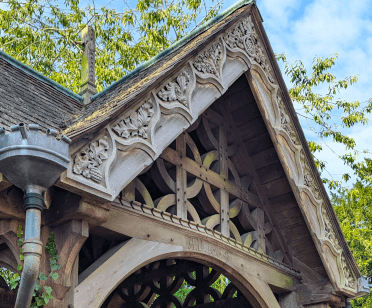
Whenever I’ve done a research walk for Contours in the past, it’s been in the off-season, when we don’t need all hands on deck in the office looking after our walkers who are actively out on the trail themselves. So this day in late July — with the forecast suggesting a high of 25C — promised to be a real change for me. We’ve written about how to prepare for summer walks in the past, and I stuck to most of the advice.

I aimed to carry roughly 500ml of liquid for every hour I planned to be on the trail (seven to eight hours, so 4L overall) and made that up with 2.5L in my hydration pack, 700ml in my reuseable water bottle, two 500ml bottles of isotronic drink and, uh, 250ml of Red Bull, canned.
If that sounds like a lot of extra weight, a filter or water purifying tablet might suit you better on your own summer walk.
I planned to walk fairly sedately and take plenty of breaks in the shade as required, eating little and often. And I dressed appropriately, too, bringing out a white long-sleeved top, borrowing a cap from my partner, and slathering myself in suncream (to be topped up every few hours).
In a moment of madness, I even brought out my singular pair of shorts (worn roughly once every 2-3 years). Would I recommend such a move to our future Shropshire Hills hikers? Perhaps. Just mind the nettles.
My ascent along wooded pathways and field boundaries soon opened up long views over patchwork farmland, at which point it became pretty obvious that the heat had kicked the farming community into overdrive. All the sheep were recently shorn, all the hay fields recently baled, and I spotted tractors and combine harvesters hard at work all over the place.


Clearly, the summer temperatures had done a brilliant job reducing moisture content in the local crops, so I was walking the area in peak harvesting season. I never would have seen this industrious activity — or been treated to the smells of the fresh-cut fields — had I been walking the trail in winter.
My favourite summer moment took place as I was heading along a footpath neatly cut through a field of wheat. A rabbit or some other small creature stirred the hip-high crop, and when I paused to see if I could spot it again, I realised the whole field was popping in the heat. This unusual crackle followed me all the way across the field. I’d never heard anything like it before.
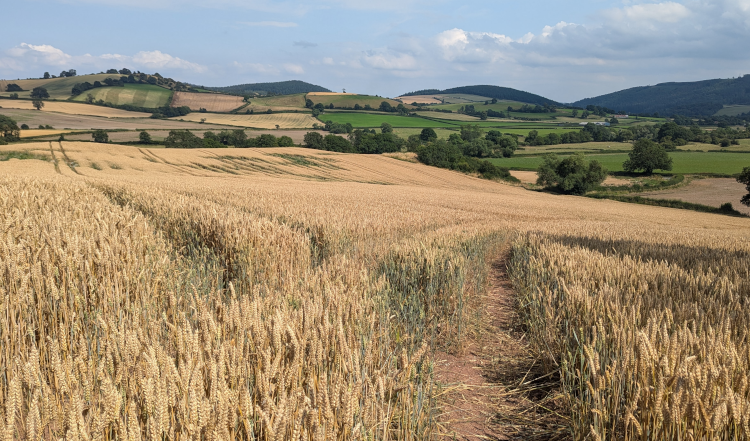
I met another rabbit later on, when it darted across a path beneath a bower of coppiced hazel and leaning willow, and an enormous buzzard I startled from its perch atop a fingerpost.
I was halfway up a hill, and possibly looking for an excuse to pause, when I heard a completely alien chirp from a nearby tree. I thought maybe I was about to spot a rare native species of bird, but no: this turned out to be my weirdest sighting on the walk. It was a bright green budgerigar. Hopefully it wasn’t too far from home; it refused to be rescued, too busy sunbathing to be tempted away.


Most of the animals along the Shropshire Hills walk are domestic animals, albeit the kind you’d expect to find on a walk like this. I met a huge number of sheep on the trail, as well as some friendly horses and several curious cows. I saw several of them up close; most barely moved away. Presumably they’re very used to walkers — or too hot to get up, nevermind leave the shade.
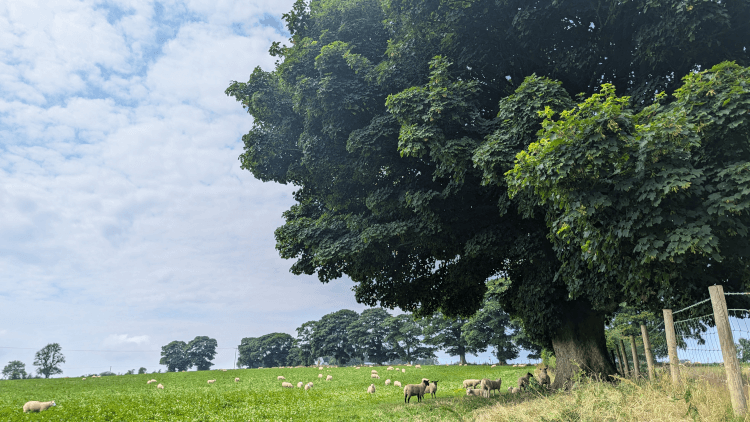
Those pools of shade were everywhere. As I mentioned earlier, this leg of the Shropshire Hills features a lot of farmland. But what English field would be complete without a wide-spreading veteran tree?

I spotted a phenomenal number of seriously old trees along this walk. Alongside the essential oaks, I met some enormous beech, maple and ash trees providing shade in the middle of far-stretching fields. I even took my lunch break beneath a particularly tent-like sycamore, whose leafy branches stretched all the way down to the ground.
The area has some well-established windbreak stands around farmhouses, too, often composed of pine and birch, and plenty of historically coppiced willow, hazel and others.

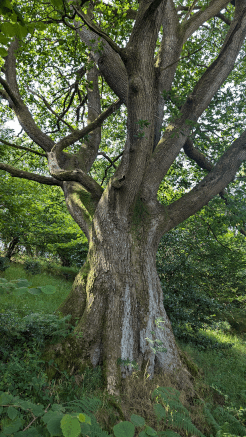

The Shropshire Hills walk favours wooded paths and streamside walking on the final stint into Clun. The best part has to be when you turn at the river and emerge into a field with the ruin of Clun Castle up ahead — there’s something special about marching toward that ancient building.
The trail even enters castle grounds, where I kept my eyes peeled for adders and was disappointed not to find any, although the ornamental pond was pretty enough to mostly make up for it. The castle grounds are free to enter, and you can walk right up to the ruins.
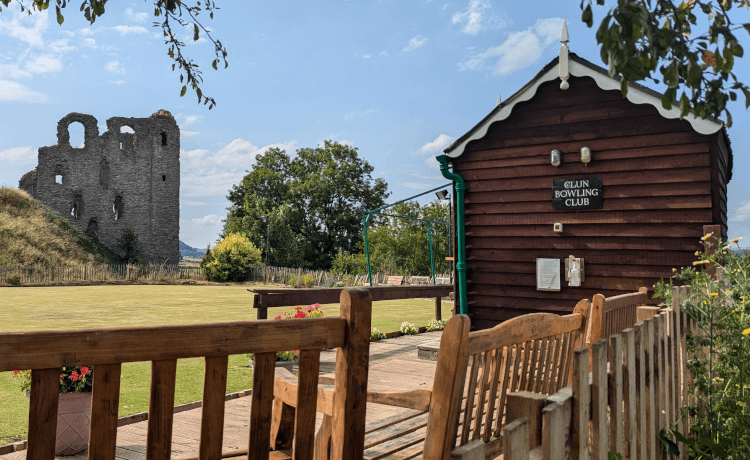
Clun itself is beautiful, composed of narrow snaking lanes between well-kept old houses complete with lush gardens and clambering vines. The town is home to the Clun Town Museum, open Tuesdays and Sundays, as well as a range of cafes and the legendary Three Tuns Inn, famed for its award-winning ales, brewed just next door in the brewery.
Sadly for me, I had to drive home from Clun and could not drop in for a taste at The Tuns. I hope any Contours customers arriving in the town on the Shropshire Hills walk will try their ale in my stead.
All in all, I found this leg of Shropshire Hills to be beautiful throughout, with plenty of activity on the hills and a few other walkers on the trail. There are several long climbs along the way, but with so much to stop and look at, I found my pace naturally levelled most of them out.


As for Contours Holidays’ route notes, they were sound throughout, requiring the same minor tweaks I made when I reviewed the Usk Valley Walk back in March.
I’m glad to have had the opportunity to test-drive and neaten up the directions for future walkers. If you’re heading out on the Shropshire Hills walking holiday this August or September, I hope you enjoy them!
Contours Holidays pride ourselves on our expert knowledge of the UK’s trails. We regularly set out to check our routes and directions and to make improvements on the holidays we offer. You can find several write-ups of staff expeditions in our Trail Diaries.
Interested in walking the Shropshire Hills?
Contours Holidays offer two itineraries for the Shropshire Hills walking holiday, spanning four or five days on the trail. Either itinerary can be dog-friendly, so why not bring your four-legged friend along for the walkies of a lifetime? Find your holiday here:

Marketing and Strategy Consultant
Writer, editor and Google-wrangler at Contours Holidays, Cass spends each weekend on the trails, walking the dog or plummeting downhill along Wales’ best mountain biking tracks.